Floodlights are an essential part of a tennis court. They provide the necessary lighting for players to see the ball and move around the court safely, even at night or in dimly lit conditions. However, like any other equipment, floodlights can malfunction or break down over time. This is where knowing to fix tennis court floodlights becomes crucial.

The main advantage of fixing tennis court floodlights is the ability to quickly resolve any issues that may arise. This ensures that your tennis court remains well-lit and fully functional, allowing players to continue playing even after dark or in unfavorable lighting conditions. You can find step-by-step instructions on how to fix tennis court floodlights in this blog article.
Types of Floodlights Used on Tennis Courts
There are various types of floodlights that can be used on tennis courts. These include:
- Metal Halide Floodlights: These are high-intensity discharge (HID) lights that produce a bright white light which is ideal for outdoor sports like tennis. They have a long lifespan and provide excellent illumination, making them a popular choice for lighting up tennis courts.
- LED Floodlights: These are becoming increasingly popular due to their energy efficiency and long lifespan. They produce a bright, consistent light that is ideal for tennis courts. They also have the added benefit of being able to be dimmed, providing flexibility in lighting levels.
- Halogen Floodlights: These are often used as a more affordable option compared to metal halide and LED floodlights. However, they have a shorter lifespan and are not as energy efficient. They produce a warm, yellow light which may not be ideal for tennis courts.
- Solar-Powered Floodlights: These are an eco-friendly option that harnesses solar energy to power the lights. They are becoming more commonly used on tennis courts due to their cost-effectiveness and minimal maintenance needs. However, they may not provide as much lighting as other types of floodlights.
- Induction Floodlights: These use a gas discharge method to produce light and have a long lifespan similar to LED lights. They are energy efficient and provide good illumination, but can be more expensive upfront.
- Combination Floodlights: Some tennis courts use a combination of different types of floodlights to achieve the desired lighting effect. For example, metal halide lights may be used for general illumination while LED lights are used for specific areas such as the playing surface.
- Mobile Floodlights: These are portable and can be moved around the court to provide light where needed. They are often used for temporary events or in areas where permanent lighting is not feasible.
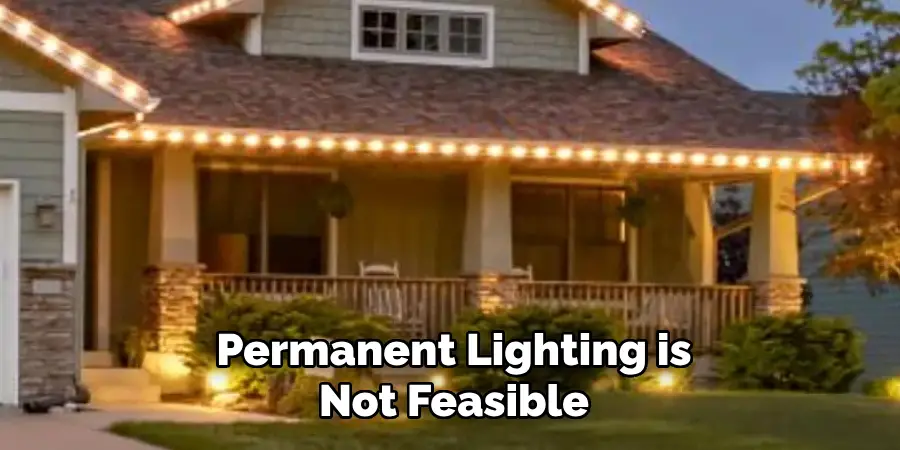
Tools and Materials Needed for Fixing Tennis Court Floodlights
- Flashlight
- Replacement bulbs
- Screwdriver
- Pliers
- Voltage tester
- Wire cutters
- Electrical tape
- Ladder
- Extension cord
- Circuit breaker
By following this list of tools and materials, you will be able to fix any issues with your tennis court floodlights. However, it’s important to note that safety is always the top priority when working with electrical equipment.
Step-by-step Instructions for How to Fix Tennis Court Floodlights
Step 1: Inspect the Floodlights
Before beginning any repairs, it’s important to thoroughly inspect the floodlights and surrounding area for any damage or potential hazards. Make sure to also turn off the power source before starting.
Step 2: Use a Voltage Tester
Using a voltage tester, check for any live wires or electrical current running through the floodlights. If there is electricity still flowing, do not proceed with the repairs. Refer to the list above for the necessary tools and materials needed for fixing tennis court floodlights. Make sure everything is easily accessible before starting.
Step 3: Replace Bulbs if Needed
If any bulbs are burnt out or damaged, carefully remove them and replace with new ones. It’s important to use the correct wattage for the floodlights. Inspect all wiring connections and make sure they are secure. Tighten any loose connections with pliers if necessary.
Step 4: Use a Circuit Breaker
If the floodlights are not turning on at all, it may be due to a tripped circuit breaker. Use a circuit breaker tester to check and reset if needed. If the circuit breaker is not the issue, check the light switches for any damage or wear. Replace if necessary.

Step 5: Examine Light Sensors
Some floodlights have sensors that may need to be adjusted or replaced. Check for any obstructions or damage and make any necessary adjustments. After completing any repairs or replacements, use a voltage tester again to ensure that there is no electrical current running through the floodlights.
Step 6: Turn on Power Source
Once all repairs have been completed and everything has been checked with the voltage tester, turn on the power source and test the floodlights. If the floodlights are still not working properly, make any necessary adjustments or repeat previous steps. After completing all repairs and ensuring that the floodlights are in working order, remember to always prioritize safety and turn off the power source before leaving the area.
By following these step-by-step instructions, you should be able to successfully fix any issues with your tennis court floodlights. However, if you encounter any difficulties or feel uncomfortable working with electrical equipment, it’s always best to seek professional help.
Safety Tips for How to Fix Tennis Court Floodlights
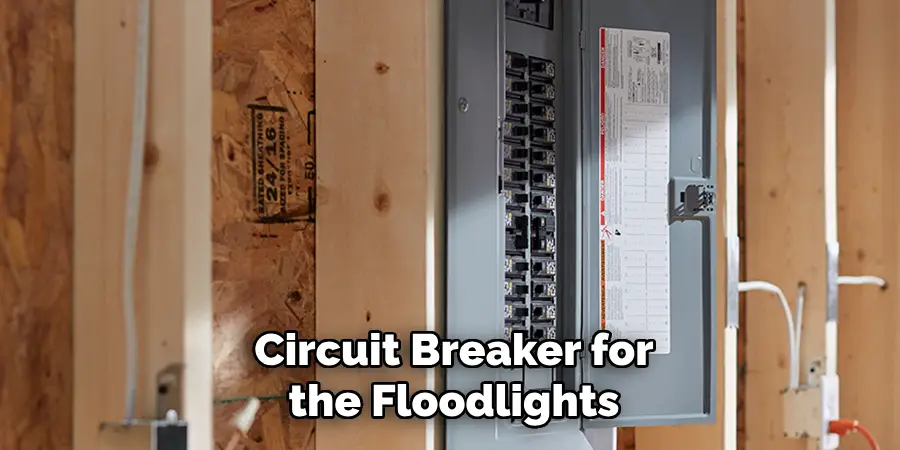
- Make Sure the Power is Off– Safety should always be the top priority when working with any electrical equipment. Before attempting to fix or replace tennis court floodlights, make sure that the power source is turned off and unplugged. This will prevent any risk of electrocution while performing maintenance work.
- Use Proper Tools and Equipment – Using inappropriate tools can not only damage the light fixtures but also pose a safety hazard. Always use the right tools for the job and ensure they are in good working condition before starting work.
- Wear Protective Gear – To protect yourself from any potential hazards, it is essential to wear appropriate personal protective equipment (PPE) such as gloves, eye protection, and sturdy shoes when fixing or replacing tennis court floodlights.
- Check the Circuit Breaker – Before starting work, ensure that the circuit breaker for the floodlights is switched off. This will prevent any accidents from occurring while working on the lights.
- Inspect for Damage – Before beginning repairs or replacements, thoroughly inspect all components of the tennis court floodlights for damage. Look out for any cracks, corrosion, or faulty wiring as these can cause serious safety concerns.
- Follow Manufacturer’s Instructions – Every tennis court floodlight is unique, and it is crucial to follow the manufacturer’s instructions when fixing or replacing them. This will ensure that the job is done correctly and safely.
- Seek Professional Help if Needed – If you are unsure about how to fix or replace tennis court floodlights, it is always best to seek professional help. Attempting to do complex electrical work without proper knowledge can be dangerous and may cause further damage.
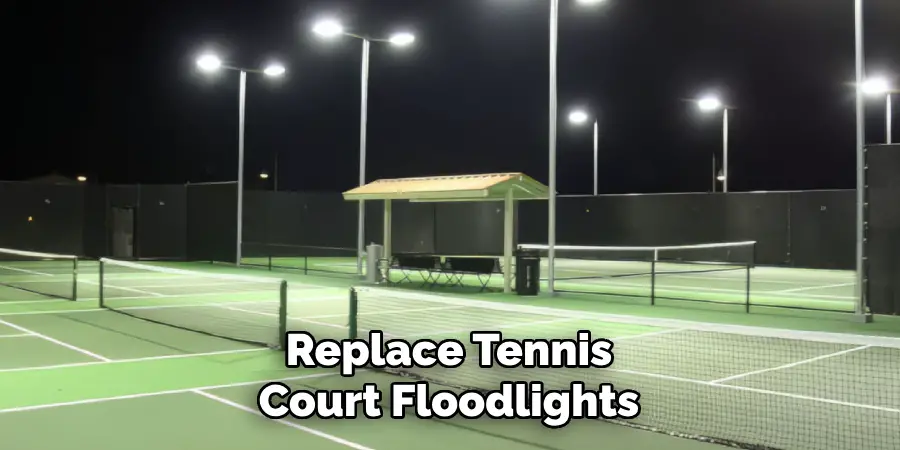
By following these safety tips, you can ensure a safe and successful fix for your tennis court floodlights. Remember to always prioritize safety and take necessary precautions while working on any electrical equipment.
Common Issues With Tennis Court Floodlights and the Need for Fixes
Tennis court floodlights are essential for playing tennis at night. They provide the necessary illumination to see the ball and play effectively. However, like any other equipment, they can experience issues that affect their functionality. In this section, we will discuss some common issues with tennis court floodlights and the need for fixes.
1. Bulb Replacement
One of the most common issues with tennis court floodlights is the need for bulb replacement. Over time, the bulbs can burn out or become damaged due to weather conditions or other factors. This results in reduced light output and can negatively impact gameplay. It’s important to regularly check the bulbs and replace them as needed to ensure proper illumination on the court.
2. Electrical Problems
Another issue that can occur with tennis court floodlights is electrical problems. These can range from minor issues such as a loose connection to more serious problems like a blown fuse or faulty wiring. Electrical problems not only affect the performance of the lights but also pose a safety hazard for players. It’s important to have a professional electrician inspect and repair any electrical issues with your floodlights.
3. Light Pollution
Tennis court floodlights are designed to provide light on the court, but sometimes they can cause light pollution. This occurs when the lights shine outside of the court and into neighboring properties or the sky.
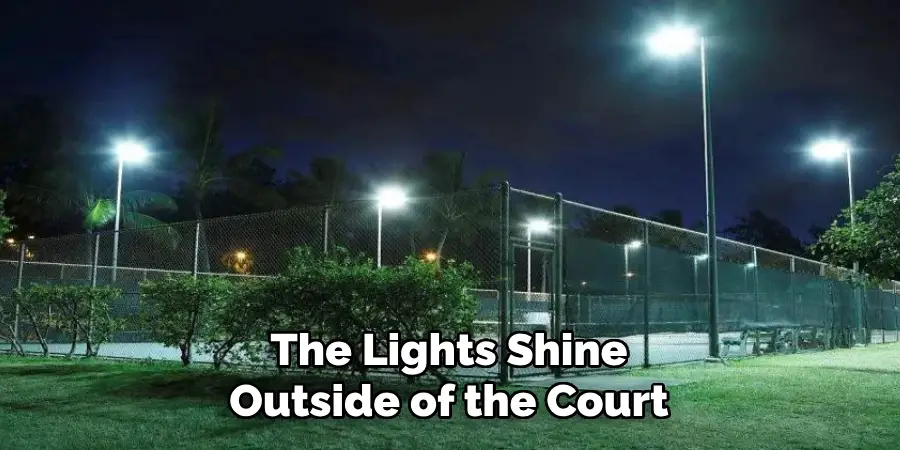
Light pollution not only disturbs those living nearby but also has negative effects on wildlife and the environment. To prevent light pollution, it’s important to properly aim and shield the floodlights, and use low-glare bulbs.
4. Maintenance
Regular maintenance is crucial for the proper functioning of tennis court floodlights. Over time, dirt, debris, and other contaminants can accumulate on the lights, reducing their efficiency and lifespan.
It’s important to clean the lights regularly and inspect them for any damages or issues that may need to be addressed. Proper maintenance can also help to prevent more serious issues from arising.
5. Energy Efficiency
Tennis court floodlights can consume a significant amount of energy, especially if they are older models. This not only leads to higher electricity bills but also has a negative impact on the environment.
To address this issue, it’s important to consider upgrading to newer, more energy-efficient floodlights. These models use LED technology and can significantly reduce energy consumption while providing the same level of illumination.
Overall, it’s important to regularly inspect and maintain your tennis court floodlights to ensure proper functionality. Addressing any issues promptly not only ensures a better playing experience for players but also helps to prevent more serious problems from occurring.
Benefits of Properly Functioning Floodlights for Tennis Players and Spectators
Floodlights are an essential part of any tennis court, whether you’re a player or a spectator. They provide crucial lighting that is necessary for both safety and visibility during evening games.
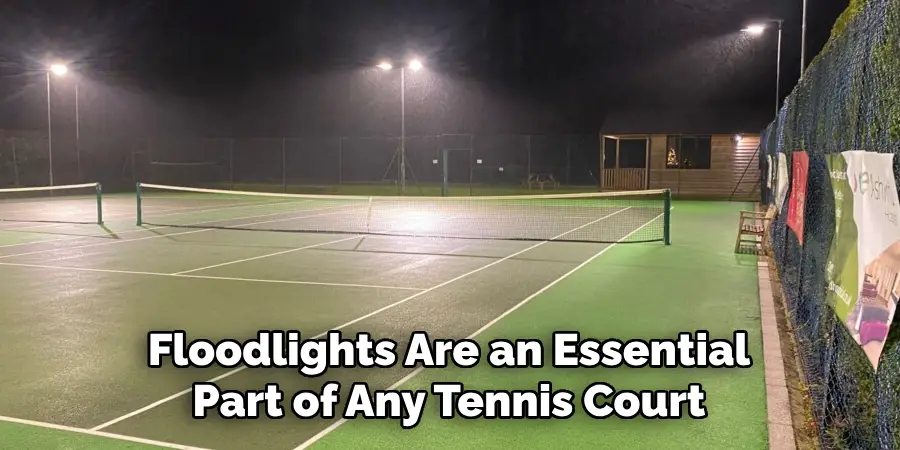
A properly functioning floodlight system can make all the difference between an enjoyable game and a frustrating one. Here are seven benefits of properly functioning floodlights for tennis players and spectators:
1. Enhanced Safety
Properly functioning floodlights provide players and spectators with enhanced safety on the court. With adequate lighting, players can see their surroundings better and avoid any potential hazards like holes or debris on the court. Spectators can also navigate their way around the stands without fear of tripping over objects in their path.
2. Extended Playing Time
With proper lighting, tennis players can continue their games well into the evening. This is especially important for competitive players who need to train or play matches after work or school. Floodlights allow for extended playing time, providing more opportunities to practice and improve skills.
3. Improved Visibility
One of the most obvious benefits of properly functioning floodlights is improved visibility on the court. With adequate lighting, players can see the ball better and make more accurate shots. Spectators can also follow the game more closely, without having to strain their eyes in the dim lighting.
4. More Convenient Scheduling
With floodlights, tennis clubs and facilities have the flexibility to schedule games and events later into the evening. This allows for more convenient timing for both players and spectators, as they don’t have to worry about playing in the scorching heat of the day or canceling games due to lack of lighting.
5. Cost Savings
Properly functioning floodlights can actually save tennis clubs and facilities money in the long run. With extended playing time, there is less need for rescheduling or canceling games due to poor lighting conditions. This means less lost revenue and fewer expenses for the club.
6. Enhanced Game Experience
For spectators, watching a tennis match under proper lighting can greatly enhance their overall experience. Floodlights provide better visibility of the players and the ball, making it easier to follow the action on the court. This can create a more enjoyable and engaging atmosphere for all involved.

7. Better Photos and Videos
With proper lighting, players and spectators can capture better photos and videos of their memorable tennis moments. Floodlights provide consistent lighting that eliminates harsh shadows and allows for clear and crisp images. This is especially important for professional matches or tournaments where media coverage is crucial.
These are just some of the many benefits of having properly functioning floodlights on a tennis court. They not only improve safety and visibility but also add convenience and cost savings to the overall tennis experience.
Troubleshooting Tips for Complex Issues
Troubleshooting complex issues can be a daunting task, especially when there are multiple factors involved. It requires patience, attention to detail, and a systematic approach to identify the root cause of the problem. In this guide, we will discuss some useful tips that can help you tackle complex issues efficiently.
1. Understand the problem
The first step in troubleshooting any issue is to clearly understand the problem. This involves gathering information about the symptoms, when and how they occur, and their impact on the system. It is important to ask relevant questions and take note of all the details to avoid making assumptions or jumping to conclusions.
2. Check for known issues
Before diving into troubleshooting, it is always a good idea to check if there are any known issues related to the problem you are facing. This can save you time and effort by providing a quick solution or workaround.
3. Isolate the issue
Complex problems often have multiple underlying causes, making it difficult to pinpoint the exact source of the issue. To make troubleshooting easier, try isolating the problem by testing different components or scenarios. This can help narrow down the potential causes and lead you to the root of the issue.
4. Review recent changes
If the problem started occurring after a recent change, it is important to review and consider its impact on the system. This could be a software update, hardware upgrade, or even a configuration change. Make sure to thoroughly review all recent changes and roll back if necessary.
5. Utilize system logs
System logs are a valuable source of information when troubleshooting complex issues. They can provide insights into errors, warnings, and other events that may have caused the problem. Make sure to check all relevant logs and analyze them for any potential clues.
6. Use diagnostic tools
In addition to system logs, there are many diagnostic tools available that can help you identify and troubleshoot complex issues. These tools range from built-in utilities to third-party software and can provide in-depth analysis of various components such as hardware, network, and software.
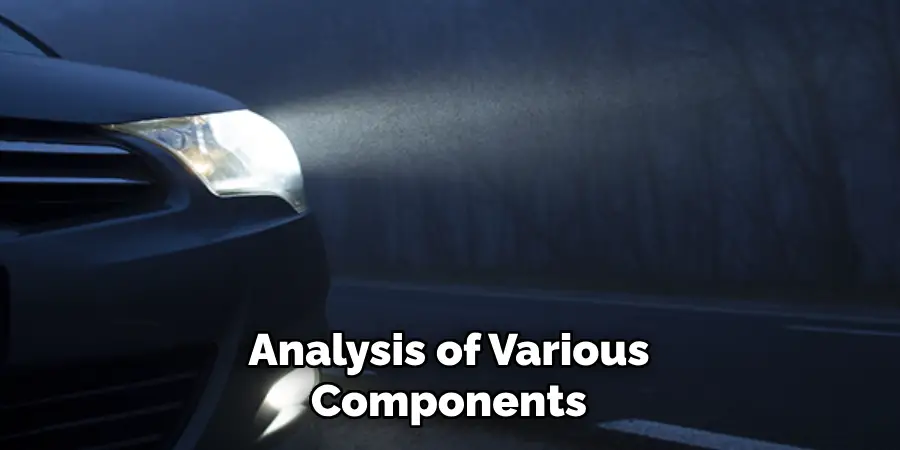
7. Collaborate with others
Sometimes, solving a complex issue requires collaboration with other team members or experts. Don’t hesitate to reach out for help or involve others in the troubleshooting process. Different perspectives and expertise can often lead to a quicker resolution.
8. Document your steps
As you troubleshoot, make sure to document each step you take and any changes made along the way. This not only helps in keeping track of your progress but also serves as a reference for future troubleshooting. It also allows others to follow your steps and can be useful in case of recurring issues.
9. Be patient
Troubleshooting complex issues can be a time-consuming process, so it is important to remain patient and persistent. Don’t get discouraged if the solution is not immediately apparent, instead, take breaks if needed and come back with a fresh perspective.
10. Learn from the experience
Finally, learning from each troubleshooting experience can help you improve your skills and become more efficient in resolving future issues. Take note of what worked and what didn’t, and use that knowledge to continuously improve your troubleshooting abilities.
By following these tips, you can increase your chances of successfully troubleshooting complex issues and minimize any potential downtime. Remember to always stay calm, focused, and methodical when approaching complex problems.
Conclusion
In conclusion, maintaining proper lighting on a tennis court is crucial for players to safely and effectively play the sport. However, when complex issues arise with floodlights, it can be challenging to troubleshoot and fix them. In this blog post, we have discussed some useful tips that can help you overcome these challenges and successfully resolve any issues with your tennis court floodlights.
From understanding the problem at hand and checking for known issues, to utilizing system logs and diagnostic tools, these tips can help you identify the root cause of the problem quickly. Collaboration and patience are also key factors in effectively troubleshooting complex issues.
I hope this article has been beneficial for learning how to fix tennis court floodlights. Make Sure the precautionary measures are followed chronologically.

